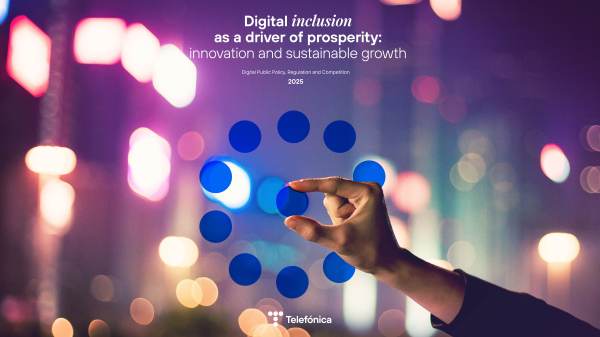A New European Cycle: The Prosperity Plan
The President of the European Commission, Ursula von der Leyen, marks an important milestone with her speech “Europe’s Choice” on 18 July 2024. In this speech, Von der Leyen outlines a concrete roadmap for closing the productivity gap and revitalising Europe’s competitiveness on the global stage. In particular, she stresses the need to invest in strategic technologies to foster innovation and maintain industrial leadership in Europe.
This speech comes at a time when all eyes in the industrial sector are on the EU: 73% of European business leaders believe that policy makers need to develop a more substantive strategic approach to ensure the region’s future competitiveness. This is reflected in ERT´s latest report “The Digital Transformation of Industry“.
The state of Europe’s digital transformation
Comparing Europe’s digital transformation with that of the United States (US) and China reveals significant differences in several key areas.
In terms of connectivity, Europe offers 79.5% of households access to gigabit networks, while the US reaches 89.6% and China 98.5% by 2023. Europe’s 5G networks cover 80% of the population, behind the US (98%) and China (89%).
When it comes to artificial intelligence, the US is investing more and taking a more aggressive approach to adopting advanced technologies, reaching 50% adoption by companies, compared to 30% in Europe and more than 60% in China.
In cloud and edge computing, Europe’s market share is less than 10%, while the US is over 50%. Cybersecurity is another critical area, where the EU is working on a robust regulatory framework but faces challenges in the face of more centralised US and Chinese strategies.
Furthermore, according to the ERT report, only between a quarter and a third of European companies believe their organisation is ready to capitalise on the opportunities of digital transformation from a talent and skills perspective.
Moreover, the weight of the digital economy in the economy also differs indicating different degrees of digital permeation. In 2022, Europe’s digital economy accounts for 5% of GDP, compared to 10% in the US or 8% in China.
This data, together with the digitisation strategies of each region, would provide us with significant data on what the keys to success of public policies in the European Union should be, taking into account the global context.
Competitiveness through the digital transformation of industries
The digital transformation of large EU industrial organisations is critical to Europe’s global competitiveness
According to ERT, eight in ten European executives agree with this statement. However, Europe is lagging behind. In its report “The Digital Transformation of Industry“, ERT calls on European policymakers to strengthen their support for digital transformation, and to position Europe as a technology leader.
In particular, it calls for an action plan for the industrial digital transformation, with sector-specific roadmaps, in line with the Letta´s report. In addition, it calls for a stronger focus on implementation, with specific funding mechanisms and frameworks for more agile resource allocation.
The ERT also stresses the importance of making progress on the digital single market and enhancing digital skills. It also calls for the exploration of new technological frontiers, such as quantum computing and industrial metaverses, with proactive approaches to shape the technology leaders of the future.
Finally, it makes recommendations for progress in the areas that European companies consider key to advancing their digital transformation.
Key areas to accelerate digital transformation of industry
These areas are: connectivity, data management, artificial intelligence, cloud computing, cybersecurity and sustainability.
Connectivity: The basis for continuous innovation
For Europe to compete in an increasingly digitalised world, the ERT considers it crucial to modernise regulations to adapt them to the new market reality.
This includes ensuring that Europe’s digital infrastructures are state-of-the-art, facilitating investment, development and deployment of emerging technologies such as the 5G and the Internet of Things (IoT). To this end, it highlights, among other recommendations, the importance of promoting the scale of telecoms operators by reducing restrictions on the in-market consolidation to create a solid foundation for continued innovation.
Data: fostering innovation through European data spaces
A well-structured data ecosystem is essential to boost the digital economy and European leadership in global innovation. The ERT therefore calls for the creation of European Data Spaces to be accelerated.
Unified framework for data management will enable European businesses to share, access and use data more efficiently and reliably. This will stimulate innovation and the development of new services and products, and enhance collaboration across sectors and countries.
Artificial Intelligence (AI): leading innovation on a global scale
AI has the power to transform entire industries by boosting their competitiveness, from healthcare to manufacturing. With innovation cycles measured in months, the ERT recommends creating a dynamic European AI ecosystem.
It therefore stresses the need to invest in AI R&D and to promote a regulatory environment favourable to experimentation and safe implementation.
Cloud and edge computing: ensuring digital autonomy
The ERT points out that the development of cloud and edge computing infrastructures are essential for Europe’s competitiveness and digital sovereignty. They not only enable faster and more efficient data processing, but also provide the flexibility to adapt to changing demand.
To strengthen European leadership in this area, the ERT recommends increasing public investment through agile IPCEI initiatives and incentivising private investment, as well as public sector adoption of the cloud.
Cybersecurity: building a more robust ecosystem
In relation to cybersecurity, the ERT recommends promoting an efficient and coherent legislative environment that fosters a robust cybersecurity ecosystem along the industrial value chain, ensuring the protection of critical data and systems. This will enhance the resilience and economic security of industries.
Sustainability: integrating technology and environment
The ERT advocates promoting the development of digital solutions (Green IT) and their adoption to advance sustainability goals (IT for Green). Integrating digital technologies into sustainability strategies will help reduce the carbon footprints, improve energy efficiency, and promote circularity and more sustainable business practices.
The ERT’s recommendations in “The Digital Transformation of Industry ” provide a roadmap for Europe to lead in the digital age. It is a call to action to modernise our infrastructures, manage data efficiently, lead in artificial intelligence, strengthen our cloud industry, build a robust cybersecurity ecosystem and promote sustainability through digitalisation.














